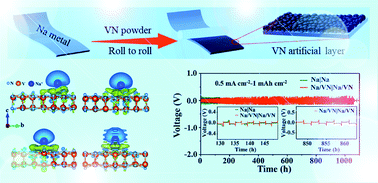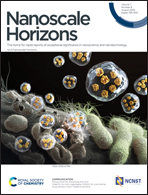A sodiophilic VN interlayer stabilizing a Na metal anode†
Abstract
Sodium (Na) metal is a very encouraging anode material for next-generation rechargeable batteries owing to its high specific capacity, earth-abundance and low-cost. However, the application of Na metal anodes (SMAs) is hampered by dendrite growth and “dead” Na formation caused by the uncontrollable Na deposition, leading to poor cycle life and even safety concerns. Herein, a high-performance Na anode is designed by introducing an artificial VN interlayer on the Na metal surface (Na/VN) by a simple mechanical rolling process to regulate Na nucleation/deposition behaviors. The density functional theory (DFT) and experiment results uncover that the VN possesses high “sodiophilicity”, which can facilitate the initially homogeneous Na nucleation and cause Na to distribute evenly on the VN interlayer. Therefore, uniform Na deposition with dendrite-free morphology and prolonged cycling lifespan (over 1060 h at 0.5 mA cm−2/1 mA h cm−2) can be realized. Moreover, the full cell assembled by coupling a Na3V2(PO4)3 (NVP) cathode and Na/VN anode presents superior cycling performance (e.g., 96% capacity retention even after 800 cycles at 5C). This work provides a promising direction for regulating Na nucleation and deposition to achieve dendrite-free metal anodes.

- This article is part of the themed collection: Nanoscale Horizons and Nanoscale: Nanomaterials for Energy


 Please wait while we load your content...
Please wait while we load your content...